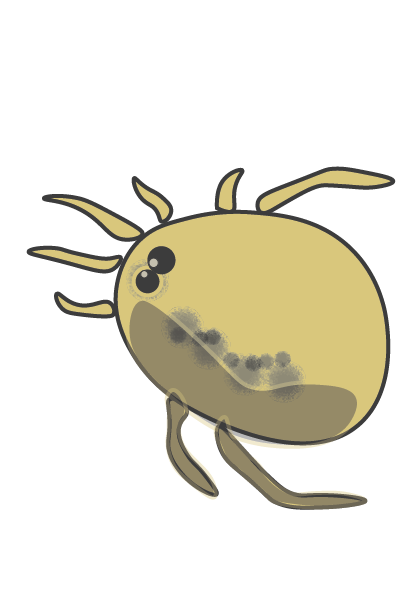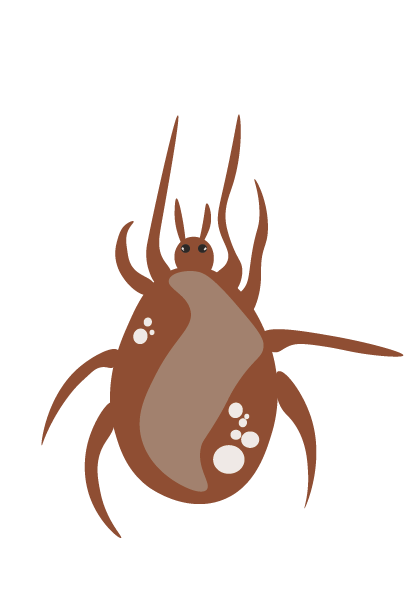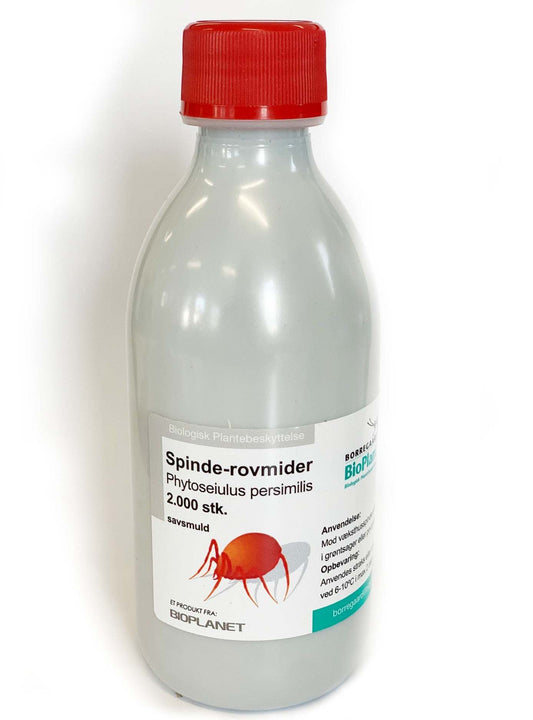Share
Spider Mites on Houseplants – How to Get Rid of Them for Good (with the Help of Predatory Mites)
You come home on a normal day and something looks wrong with your favorite plant. The leaves have small yellow dots, almost as if someone has poked holes in them with a needle. You look closer and... what is that? Thin, silvery threads between the leaves? Then you might have spider mites, one of the most frustrating pests for those of us who love our houseplants.

But the good news: spider mites are easy to get rid of, and there's actually a way that works long-term without you having to spray chemicals every week. The solution is called predatory mites, and these little heroes will literally eat up your spider problems.
Quick Guide - The Most Important Things About Spinning Potted Plants
What are spider mites?
Small red or yellow mites (0.5 mm) that suck plant sap. Thrive in dry, warm air, which is why they are so common indoors. Lay eggs on the underside of leaves
How to Recognize the Damage:
Small yellow dots on leaves. Thin webs between leaves and branches. Leaves turning yellow and wilting, especially common on Alocasia, banana plants and other green plants
Best Treatment:
Prevention: Californicus (allow predatory mites to settle before problems arise)
Curative: Phytoseiulus (rapid attack on existing spiders)
Feel free to combine both for maximum effect.

What Are Spider Mites Actually?
Spider mites, also known as red spider mites or two-spotted spider mites, are not spiders despite their name. They are small mites that feed by sucking the sap from your green plants. The most common species we see on indoor houseplants are the two-spotted spider mite ( Tetranychus urticae ) and the crimson spider mite ( Tetranychus cinnabrinus ).
This is what they look like:
Adult mites are oval and about 0.5 mm in size. Their color varies from yellow-brown to red-brown depending on what they eat. The eggs are small, white balls (0.1 mm) that are laid on the underside of leaves.

What makes spider mites especially troublesome for indoor houseplants is that they thrive perfectly in our heated homes. Dry air and warm temperatures, just like we have in the winter, are like a spa vacation for spiders.
How to Detect Spin Early
The big secret to successfully controlling spider mites is to detect them early. Spider mites reproduce incredibly quickly, under optimal conditions a generation can develop in just 7 days!
First Signs to Look For:
- Small yellow dots on the leaves, especially on the upper side
- Sticky, thin webs between leaves and shoots
- Leaves that lose color and turn yellowish
- Small moving dots on the underside of the leaves when you look closely

Where to Find Them First: Spider mites almost always start in the warmest, driest places. Look especially closely at plants that are:
Near radiators or heat sources
In direct sunlight
In dry places with poor air circulation
Simple Test: Hold a white piece of paper under a suspicious branch and shake gently. If small moving dots fall onto the paper, you probably have spin.
Preventive vs Curative Treatment – What’s the Difference?
Before we dive into the treatments, it is important to understand the difference between preventive and curative treatment:
Preventative treatment means releasing beneficial insects before you have a problem. They establish themselves on the plants and "guard" so that any spider mites are eaten before they become a problem.
Curative treatment is used when spider mites have already set in and you see damage to the plants. Then you need predatory mites that act quickly and intensively.
We always recommend combining both, starting preventively and adding curative when needed.
How to Prevent Spines on Houseplants
The absolute best strategy against spin is prevention. It is much easier to stop a problem before it occurs than to solve it afterwards.
Californicus predatory mites; Your Preventative Bodyguard
Californicus is perfect for spider mite prevention & control on indoor houseplants. These predatory mites are like little bodyguards for your plants, they constantly patrol and eat any spiders before they have time to establish themselves.

Why Californicus Works So Well Prevention:
- Can survive without prey by eating pollen
- Withstands changing temperatures and humidity
- Attacks spiders in all stages: eggs, larvae and adults
- Works best when the spider population is small (thus perfect prevention)
How to Use Californicus: Californicus comes in small bags that are hung on the plants. Hang the bags inside the plant, protected from direct sunlight. Do not touch the bags more than necessary, predatory mites are sensitive to handling. The bags should be replaced every 4-6 weeks.
When to Start: Ideally, you release Californicus outside when the plants start to flower, even if you haven't seen any spins yet. For indoor houseplants, we recommend starting in early spring when the light increases and the plants become more active.
Other Preventive Measures:
Increase the humidity around the plants (spider mites hate humidity). Avoid placing plants too close to heat sources, as spider mites multiply faster in warm weather. Shower the plants regularly to flush away any spider mites.
Curative Treatment – When Spin Has Already Set in
If you find that spider mites have already established themselves on your houseplants, you need to act quickly. This is where Phytoseiulus comes into play.

The image shows a very strong burst of spin.
Phytoseiulus: The Spider Mites' Worst Nightmare
Phytoseiulus persimilis is a predatory mite that feeds exclusively on spider mites. It is like a specialized hunter with only one goal: to eat as many spiders as possible.
Impressive Appetite: A single Phytoseiulus mite can eat: 20-25 spider mite eggs per day, 20-30 larvae and nymphs per day and 5 adult spider mites per day
This means that even a small population of predatory mites can quickly be overcome by a spider mite outbreak.

Why Phytoseiulus is so Effective: Develops faster than spider mites (wins the race). Eats only spiders (no confusion about what to hunt). Able to locate spiders even in small numbers. Can save plants from serious infestations in just a few days
How to Use Phytoseiulus: Predatory mites come in a bottle that you gently shake over the plants. Concentrate the release on the most affected areas, but don't forget to treat surrounding plants as well.
Dosage for Houseplants:
Early detection: 6-12 individuals per square meter
Late detection/severe infestation: at least 20 individuals per square meter
Hotspots: 100+ individuals per square meter
Practical Tips for Success
Timing is Everything: Never release predatory mites in direct sunlight or when it is too hot. Early morning or late afternoon is best.
Humidity Helps: Increase the humidity around the plants. Spider mites thrive in dry air, while predatory mites prefer a little more moisture. A humidity of 60-70% is ideal.
Combine Systems: For best results, use Californicus preventatively and have Phytoseiulus ready as a backup. Many successful growers run both systems in parallel. Especially in greenhouses!
Be Patient: Predatory mites work day and night, but it may take 1-2 weeks before you see clear results. Give them time to work.
Avoid Chemicals: Do not use insecticides when you have predatory mites. They are killed by the same agents as spider mites.
Common Mistakes to Avoid
Mistake #1: Waiting too long The longer you wait, the harder it becomes to gain control. Spins multiply exponentially.
Mistake #2: Too little dosage It is better to release too many predatory mites than too few. The excess predatory mites will disappear naturally when the food runs out.
Mistake #3: Treat only affected plants Spider mites spread quickly to nearby plants. Always treat a larger area than where you see damage.
Mistake #4: Giving up too soon Predatory mites need time to establish themselves and find all the spiders. Give them at least 2-3 weeks before judging the results.
How to Get Rid of Spiders on Common Houseplants
Spider mites on Monstera: Monsteras are magnets for spider mites, especially the large leaves that often dry out between waterings. Spider mites tend to collect along the veins and on the undersides of the leaves. Start with Phytoseiulus if you already see the characteristic yellow spots, and follow up with Californicus to prevent recurrence. Monsteras tolerate both systems very well.
Spider mites on Silver Vine: Silver Vine often gets spider mites when hanging near heat sources or in too dry air. The thin leaves show damage early, which is actually a good thing, you discover the problem quickly. Shower the plant first to wash away as many spider mites as possible, then use Phytoseiulus on the worst affected branches.
Spider mites on Philodendron: Philodendron species, especially those with larger leaves such as Philodendron Pink Princess or Brasil, can suffer extensive spider infestations. Concentrate Phytoseiulus treatment on the underside of the leaves where spider mites hide. Many philodendron species respond quickly to treatment.
Anthurium spider mites: Anthurium spider mites can quickly cause the leaves to turn yellow and wilt. Use both Californicus preventively and Phytoseiulus curatively, but be extra careful to increase the humidity at the same time.
Spines on Alocasia: Alocasia species such as Alocasia Polly or Zebrina often get spins along the prominent leaf veins. Their large, beautiful leaves show damage clearly, so you can act quickly. Californicus works great as a preventative on alocasias, while Phytoseiulus solves acute problems effectively.
Spider mites on Syngonium: The dense plant mass of Syngonium can hide spider mites for a long time before you notice them. Check the underside of the leaves regularly, especially on older leaves at the bottom. Phytoseiulus can also reach hard-to-reach places in the dense plant.
Spider mites on Ficus (Rubber Tree): Ficus species such as Ficus Elastica or Ficus Lyrata are classic spider mites magnets. The thick, leathery leaves often hide early signs of spider mites. Start treatment as soon as you see the first yellow spots - don't wait until the spider webs become visible. Both Californicus and Phytoseiulus work great on ficus species.
Conclusion – Predatory Mites are the Future
After many years of fighting spider mites on our own plants and helping customers with the same problem, we have learned one thing: predatory mites work. They are not only effective, they are also the most sustainable solution.
Instead of spraying chemicals every week, you build a natural defense that works 24/7. Californicus gives you security and preventive protection, while Phytoseiulus solves acute problems quickly and effectively.
Yes, it takes a little planning and patience. But once you see how predatory mites methodically clean up your plants from spider mites, and when you notice that the problems become fewer and less severe, you will understand why we always recommend beneficial animals as the first choice against spider mites.
Remember: spider mites aren't a sign that you're bad at plants. They're just part of the reality of growing indoors. But with the right tools, and predatory mites are definitely the right tools, you can keep them under control and enjoy healthy, green plants all year round.
Do you have questions about spider mite control or which predatory mites are right for your plants? We have probably fought the same spiders that are plaguing you right now, so please get in touch!







